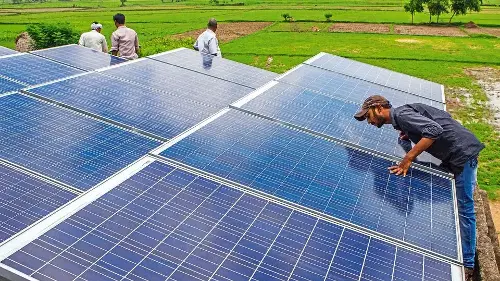
New Delhi: Upcoming solar power projects in the country are set to have energy storage systems integrated at the sites to ensure uninterrupted supply of renewable power and maintain grid stability.
The Central Electricity Authority (CEA) has asked state power utilities and renewable energy implementation agencies to incorporate two-hour co-located energy storage systems, equivalent to 10% of the installed solar project capacity, in future solar tenders.
"This requirement will help mitigate intermittency issues and provide critical support during peak demand periods. A suitable compliance mechanism may also be explicitly mentioned in the bid document to ensure the availability of storage during non-solar hours," the CEA said in an advisory on Tuesday.
The CEA, which advises the government on matters related to the national electricity policy and formulates electricity system development plans, suggested that power distribution companies (discoms) may also consider mandating two-hour storage with rooftop solar plants to improve reliability of supply at the consumer-end and lower the pressure during solar hours.
The development comes in the backdrop of the government’s plan to achieve 500 GW of non-fossil power generation capacity by 2030. The majority of the 500 GW would comprise renewable power such as solar and wind energy, both intermittent in nature and not available round the clock, which may render the power grid unstable. Storage capacity would ensure the supply of renewable power round the clock.
The CEA said in its letter to state governments, central generating stations and renewable energy implementing agencies that energy storage systems would be essential to ensure grid stability, reliability and optimal energy utilisation. Energy storage systems can help address intermittency challenges by storing excess energy for use when the supply of green power is less, ensuring a more reliable and stable grid.
Capacity requirement
India had an installed energy storage capacity of 4.86 GW including 4.75 GW of pumped storage projects (PSP) and 0.11 GW of battery energy storage systems (BESS) at the end of December.
According to the National Electricity Plan, in order to integrate the targeted 364 GW of solar and 121 GW of wind capacity by 2031-32, India would require 73.93 GW/411.1 GWh of storage capacity (26.69 GW/175.18 GWh from PSP and 47.24 GW/236/22 GWh from BESS).
The CEA noted that implementation of its advisory would result in the installation of 14 GW/28 GWh of storage by the end of this decade.
It said storage systems can be run either in a single-cycle operation where they are charged using the co-located solar power and discharged during evening hours, or in double-cycle operation where in addition to solar power, they can be charged using energy from the grid during lower demand hours and discharged during peak hours.